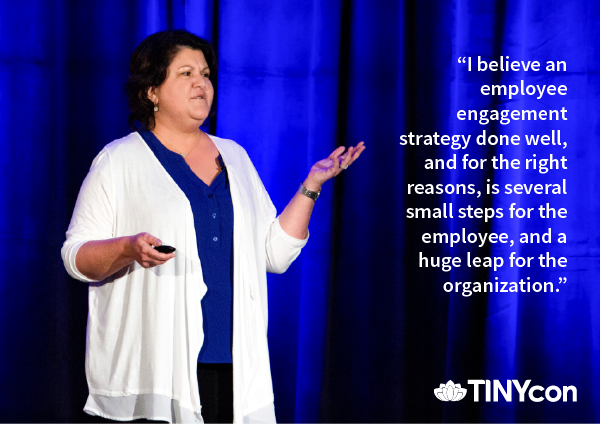3 Steps for Launching an Employee Engagement Strategy
Companies are increasingly shifting focus to employee engagement strategies, as data has shown higher staff retention and productivity linked with higher staff engagement rates.
This shift is for good reason — only 33 percent of U.S. employees are engaged, according to Gallup’s 2017 report. And 51 percent of employees are actively keeping their pulse on the job market, whether they’re actively engaged or not.
“That’s a big number!” said Crescent Bank & Trust’s Darleen Lenyo at TINYcon 2018.
Within a two-year period, Lenyo and her team have turned around employee engagement at their company, putting a priority on communication, data analysis, and strategy implementation. Although employee engagement takes effort at all levels of a company, Lenyo says it’s worth it. In fact, she compared this effort to putting a man on the moon.
“I believe an employee engagement strategy done well, and for the right reasons, is several small steps for the employee, and huge leaps for the organization,” she said.
Here’s how Lenyo and her team did it:
1. Prioritize Open Communication
Employee turnover has a huge impact on the health of a company. In fact, Gallup’s 2017 report estimates that $400-600 billion is lost in revenue due to lost productivity when turnover arises.
“Engaged employees have an impact on the economic state of the company,” Lenyo said.
Initial results from TINYpulse along with a cross-comparison of this data with Gallup poll results pointed at a large communication gap at Crescent Bank & Trust. So the company began sharing monthly financial statements with the entire staff. This promoted transparency while also emphasizing open communication. Lenyo said the company’s chief financial officer also opened the door for employee questions on the company’s financial status.
“It tells everyone what the financial goal is and reminds everyone that we all have a part in achieving that goal,” Lenyo said. This, in turn, also helps grow employee connection with large-scale goals and buy-in.
“At Crescent Bank & Trust, our team believes we need to communicate something 13 times to ensure everybody gets it,” she said.
To achieve this, they rolled out their internal communication strategy with different touch points. This included SharePoint, email, monthly magazine, TVs with information, and a Wall of Wins. They used these platforms to identify company goals and achievement of those goals, or “wins.” They also used this to communicate employee engagement data from TINYpulse, using it as an opportunity to educate staff about what employee engagement is. They also opened the conversation for employees to give leadership suggestions or comments.
“Post your wins everywhere that you can! It has such a positive impact on the overall engagement,” Lenyo said.
However, Lenyo highlighted that this communication must feel authentic to the company’s identity in order to effectively engage employees. So although adjustments might need to be made at every touchpoint, the overall message should stay the same.
“It’s about how we can take the message and stay true to it, but change it a bit to get more buy-in from more people,” she said.
In fact, Lenyo said the company also began bimonthly Q&A sessions with leadership that were employee-driven. This was a way to bust communication silos while also emphasizing transparency in leadership. Videos were also recorded for these sessions, but throughout the entire process, the tone and messaging in the videos remained consistent — “more casual, chatty, and approachable than other banks,” Lenyo said.
“We wanted to make sure that the message, and how we were conveying that information, was true to who we are,” she said.

2. Level set on Expectations
As a part of their data analysis, Lenyo said their company compared their own employee engagement data with Gallup’s data in order to see where they fell among other companies. They also studied “The Good Jobs Strategy” by Zeynep Ton, which breaks down employee engagement into a set of needs:
Basic Needs:
1. Pay/benefits
2. Schedules
3. Career path
4. Safety and security
Higher needs
1. Meaningfulness
2. Growth
3. Achievement
4. Belonging
5. Recognition/Reward
Lenyo said her team learned that they needed to solidify the basic needs before striving to achieve higher ones, because basic needs are expected.
“People expect those basic needs. It doesn’t add to your employee engagement, it subtracts from it if it’s not there,” she said.
By looking at these basic needs, they realized that their company needed to ensure that they were setting clear expectations.
Gallup 2017 report data shows that six in 10 employees strongly agree that they know what is expected of them at work.
“If we can raise this to eight in 10, we can increase things like productivity and reduce things like turnover,” Lenyo said.
She recommends that teams define and discuss expectations so that everyone is clear.
“They’re painting the picture of what outstanding performance looks like, not just leaving it to the employee to guess,” she said.
She also recommends that managers and employees communicate how their individual goals with the team fulfill higher goals at the department and organizational levels. This ensures that the individual has more attachment to the company as a whole.
Lenyo also says that these conversations should not be reserved for the annual review — they should be ongoing conversations throughout the year that are collaborative and allow the employee to contribute.
3. Encourage Accountability
Gallup’s 2017 report data shows that only three in 10 employees agree that their associates or employees are committed to doing quality work.
Lenyo said it is crucial that employees feel this way not only about their own work, but about the work of their peers, as this can have a domino effect for an entire team.
Lenyo said if someone on a team is believed to not be putting in the effort they could be, they end up setting the standard for the entire team. This, in turn, lowers employee engagement. She said that their company has set goals to overcome this by having more strategies for peer-to-peer accountability as well as standards for tasks that are created by teams themselves.
The company also introduced Objectives and Key Results (OKRs). This process pushes employees to look at new ideas but only hone in on those that help achieve organization-wide results.
A Worthwhile Process
Lenyo said that when they began analyzing their TINYpulse data, they were careful to balance research with implementation.
“When you decide to start measuring employee engagement, it’s important to take the data and act quickly with it,” she said.
Although employee engagement is an organization-wide initiative, leadership need to take somewhat of a customized approach with individual departments in order to get buy-in, and ultimately, achieve results.
“Not everybody is on the same page at the same time,” she said. “It’s important to recognize that in your employee engagement strategies and not treat everything as one size fits all.”
Although it’s a process, Lenyo said, it’s worthwhile. Kind of like putting a man on the moon.
“Although it’s a process, it’s worthwhile. Kind of like putting a man on the moon."
READ MORE LIKE THIS:
Share this
You May Also Like
These Related Stories

3 Reasons Why Your Annual Employee Engagement Survey Is Useless

25 Impactful Employee Survey Question Examples




.png?width=534&height=632&name=blog%20ad%20(1).png)
